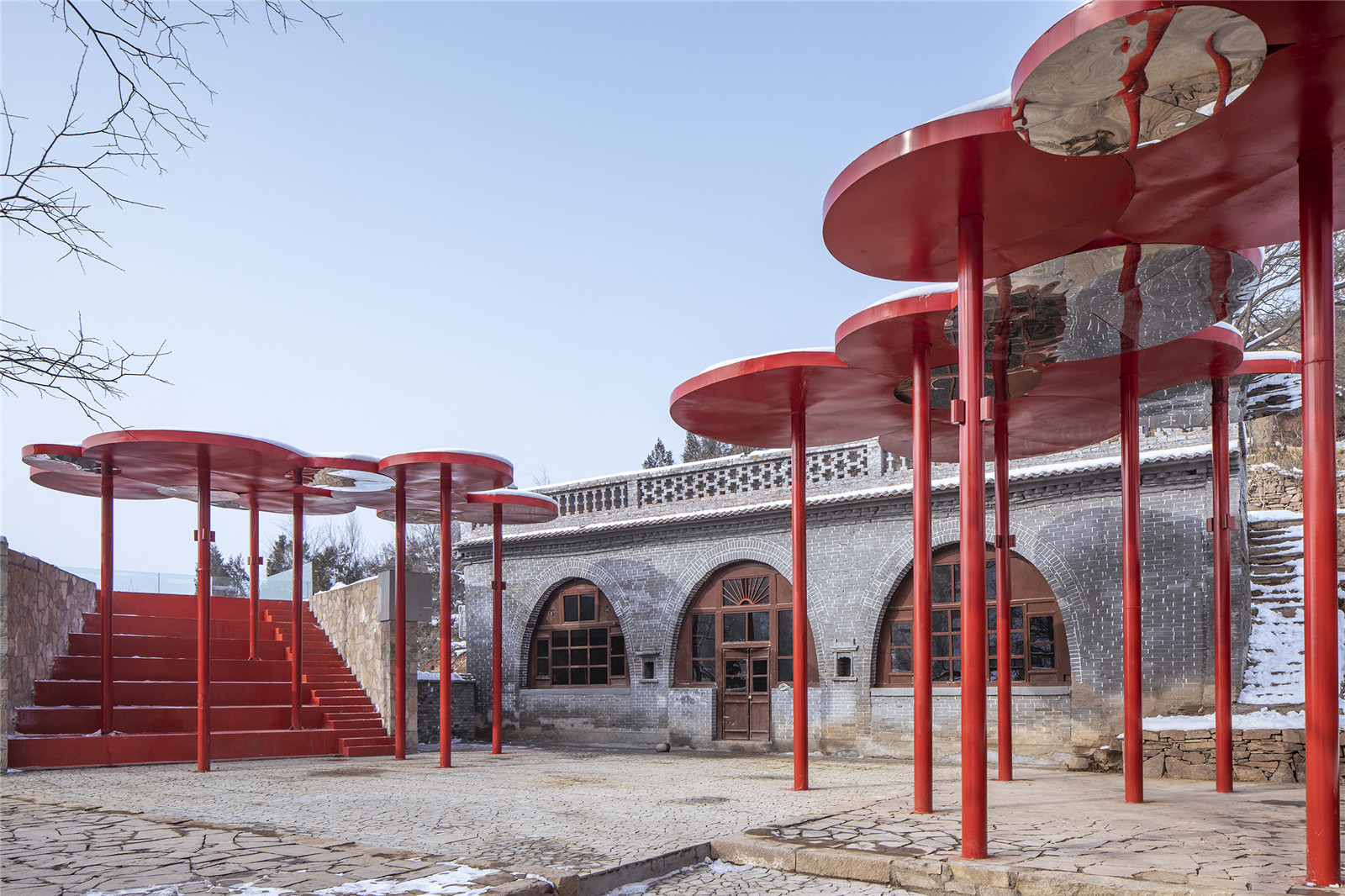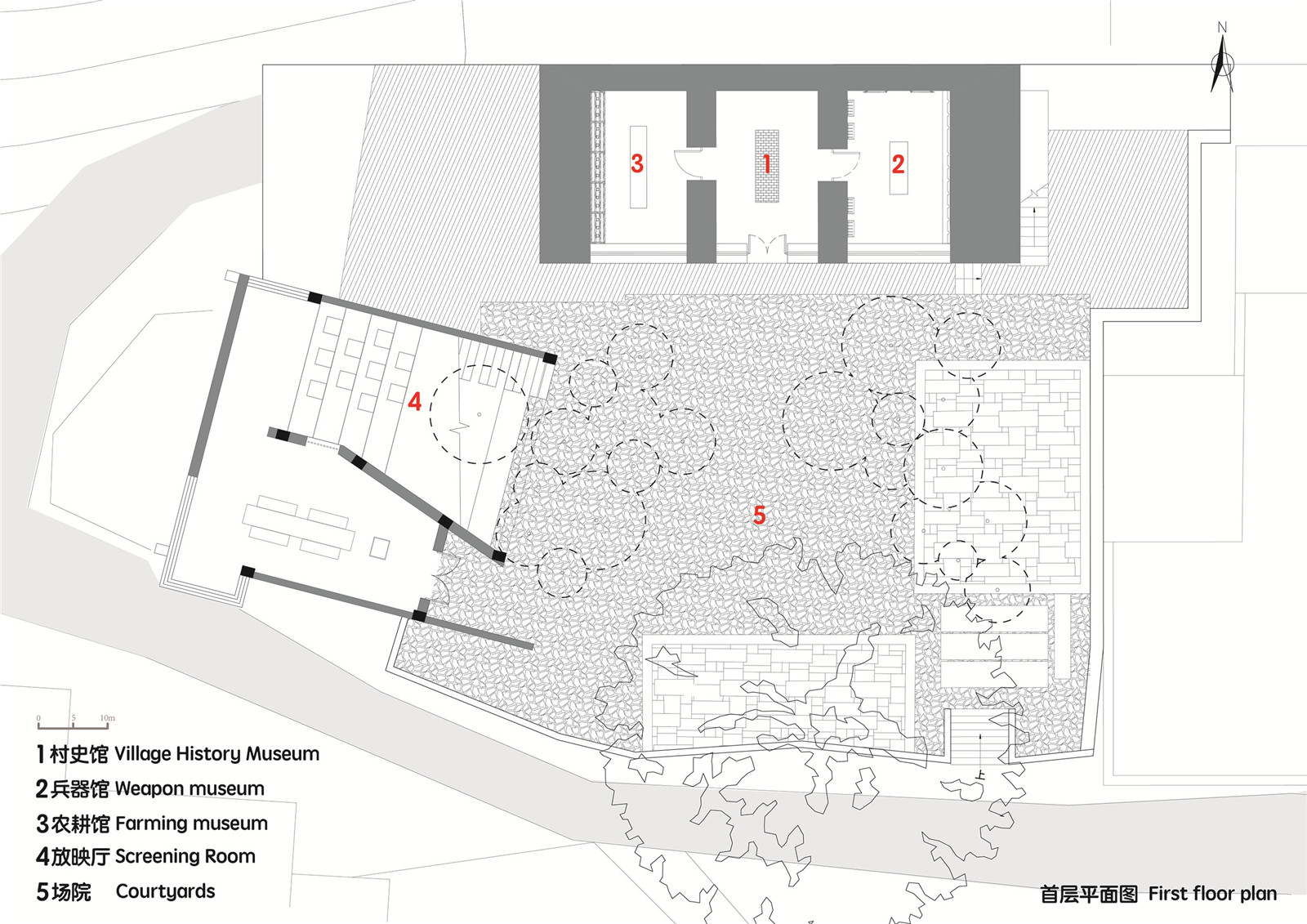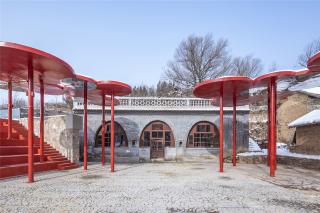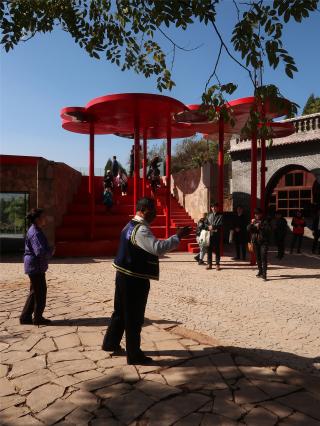大槐树下的场院,山西韩洪沟乡村公共空间设计 | 三文建筑
-
项目名称:山西大槐树下的场院景观设计
-
项目地点:山西省沁源县沁河镇韩洪沟村
-
项目规模:场地面积:800平方米 建筑面积:250平方米
-
设计公司:
-
委托方:沁源县人民政府
-
建成时间:2019年11月
-
图片来源:金伟琦,何崴
▼大雪中的村落,红色装置格外醒目
Village in heavy snow with red installation particularly striking

▼大槐树和新元素
Big locust tree and new elements

场地现状:老村的公共空间和精神之地
Site status: public space and spiritual place of the old village
项目位于山西省沁源县韩洪沟老村。村庄位于县城东部城郊结合处,距离县城4公里。村庄始建于明洪武年间,因村中有一条泄洪沟而得名。全村共有138户,人口488人。老村现状绝大部分人口已经迁至新村居住,老村中只有4户居民常住。
老村与新村毗邻,村庄原始格局完整,自西向东呈多级台地地形;建筑依地形而建,大致分为土墙双坡顶民居,窑洞两种,平地区域多为双坡顶民居,山坡边以窑洞为主。老村建筑传统风貌保持良好,保留有古树、古护坡等历史痕迹,具有较高的文化价值。此外因为是抗战时期太岳区党政军机关后勤部门的所在地,村庄中还留有多处当年红色记忆的旧址,也为韩洪沟村未来发展提供了支点。
老村绝大部分房屋属于闲置状态,常年无人居住和年久失修使大部分房屋或多或少存在损坏情况;此外,人口的外迁,缺乏产业支撑,也使韩洪沟老村日渐凋敝。如何在保留村庄传统面貌的同时,植入新的产业,拉动村庄经济,改善环境和村民生活质量,增强村庄活力,最终完成乡村振兴,是本次工作面临的挑战和需要解决的问题。
The project is in the old Hanhonggou Village, Qinyuan County, Shanxi Province, China. The village is located at the junction of the eastern suburbs of the county, 4 kilometers away from the county seat. The village was built in Hongwu Period of Ming Dynasty, named after a flood discharge ditch in the village. There are 138 households in the village, with a population of 488. At present, most of the population in the old village has moved to live in the new village, and only four residents in the old village live there.
The old village is adjacent to the new village, and the original pattern of the village is complete. From west to east, the village is in a multi-level platform terrain. The buildings are built according to the terrain, which can be roughly divided into two types, i.e. residential houses with earth wall and double slope roofs, mostly in the flat area, and cave houses, mostly near the hillside. The traditional features of the old village buildings are well preserved, with the historical traces of ancient trees and ancient slope protection, which has a high cultural value. In addition, because it was the location of the Logistics Department of the party, government and army in Taiyue District during the Anti-Japanese War, there were many old sites with red memories of that year in the village, which also provide a fulcrum for the future development of Hanhonggou Village.
Most of the houses in the old village are in idle state and, because of the uninhabited and disrepair all the year round, are more or less damaged. In addition, the continuously moving out population and the lack of industrial support also make the old village in Hanhonggou wither day by day. How to keep the traditional face of the village, at the same time, implant new industries, promote the village economy, improve the environment and the quality of life of the villagers, enhance the vitality of the village, and finally complete the revitalization of the village, are the challenges and problems to be solved in this work.
▼场地原貌
Original situation of site(摄影:何崴)

本项目是韩洪沟老村整体复兴计划一部分,基地是一个三合院,位于韩洪沟老村中部,地势较高。院落中有一个处空置的三孔窑洞,现状保持较好,但厢房、倒座、围墙和院门已经坍塌,只剩下基础的石块。场地中最为重要的元素是院外的大槐树。它已经有数百年的树龄,但仍然枝繁叶茂,如同神灵般守护着村庄。听村里老人介绍,大槐树下一直是村民集会的地方,以前是韩洪沟老村重要的公共空间,也是村庄的精神之地。
This project is a part of the overall rehabilitation plan of the old Hanhonggou Village, of which the base is a courtyard, located in the middle of the old village, with high terrain. There is an empty three-hole cave house in the courtyard. The current situation is good, but the side rooms, a reversely-set house (north facing house opposite to the main house), walls and gates have collapsed, leaving only the foundation stones. The most important element in the site is the big locust tree outside the yard, which is hundreds of years old, but still full of branches and leaves, guarding the village like a god. According to the introduction of the old people in the village, under the big locust tree has always been the place where villagers gather, which used to be an important public space and the spiritual place of the old village.
空间营造:重塑场所精神,并给予新的气质
Space construction: reshape the genius loci and endow new temperament
正如韩洪沟老村的现状一样,大槐树也已经物是人非,昔日的熙熙攘攘早已不复存在。如何重新建构乡村公共空间,从而重新塑造场所精神(genius loci)是本次设计的重点。此外,设计师也不希望只是简单的重复历史,毕竟韩洪沟老村已经有了新的产业定位,即:基于地域建筑风貌和红色历史传承的乡村旅游。新的乡民,新的产业定位,需要大槐树和树下空间扮演新的角色。
Just like the current situation of old Hanhonggou Village, the big locust tree has changed, and the bustling of the past no longer exists. How to reconstruct the rural public space, so as to reshape the spirit of place, the genius loci, is the focus of this design. In addition, the designer does not want to simply repeat history. After all, the old Hanhonggou Village has a new industrial orientation, that is, rural tourism based on regional architectural style and red historical heritage. New villagers and new industrial orientation need the big locust tree and the space under it to play a new role.
▼改造后的场地
Reconstructed site

▼草图-1
Sketch-1

▼草图-2
Sketch-2

设计师将新功能设定为乡村记忆馆和小剧场。老窑洞被整修,外观保持原貌,室内空间被重新布置为小型历史展厅,用以展示韩洪沟老村的历史和抗战时期太岳军区的事迹。坍塌的厢房和倒座并没有被恢复,设计师并不希望简单的“修新如旧”,而是希望通过新建筑物的加入,给予场地新的场所精神。
The designer set the new functions as rural memory hall and small theater. The old kiln cave was renovated, its appearance remained unchanged, and the interior space was rearranged as a small historical exhibition hall to show the history of old Hanhonggou Village and the deeds of Taiyue military region during the Anti-Japanese war. The collapsed wing rooms and inverted seats have not been restored. The designer does not want to simply "build new as old", but hopes to give the site a new spirit of place through the addition of new buildings.
▼新建的看台、红色伞状装置与老窑洞
Newly built audience grandstand, red umbrella installation and old cave dwelling

▼由老窑洞改造的村史馆
Old cave dwellings transformed into Village History Exhibition Hall

▼从场地下面的道路能看到突出的剧场
Overhanging theater seen from road below the site

昔日村民聚集在大槐树下,互通有无,互相交流的场景给了设计师灵感。这是一个半开放的公共空间:大树的树冠限定了场所的“边界”,树冠、阴影和人的活动构成了场所的气质和场所中的事件。这是一种公共空间的原型。
In the past, the villagers gathered under the big locust tree to communicate with each other, which inspired the designer. This is a semi open public space: the crown of the tree defines the "boundary" of the place, and the crown, shadow and human activities constitute the temperament of the space as well as the events in it. This is a prototype of public space.
▼改造后的窑洞外观与红色装置
Remoulded cave dwelling and red installation

▼场地成为村庄新的公共空间
Site as new public space of village(摄影:何崴)

▼村民与红色装置
Villagers and red installation(摄影:何崴)

设计师希望用一种新的、“似是而非”的设计语言,重现这一场景,这一原型。一组伞状的构筑物被设计出来,“伞帽”大小不一,彼此连接,形成由多个圆组成的不规则的“顶”,它覆盖了院落1/4的面积,并隐约成围绕大槐树的半环抱状。院落西侧倒塌厢房的位置,一个室外看台被构建起来,它呈梯形,东低西高,与老窑洞、大槐树,以及伞状构筑物一起,重新定义了场地的空间属性。室外看台一方面为室外剧场提供了观众的座位,另一方面也为俯视村落提供了一个高点。
The designer hopes to reproduce the scene and prototype with a new "specious" design language. A group of umbrella-like structures are designed, with caps in different sizes and connected with each other, forming an irregular "top" composed of multiple circles. It covers 1 / 4 of the courtyard area and looms into a semi encircling shape around the big locust tree. The location of the collapsed wing room on the west side of the courtyard, an outdoor stand is constructed, which is trapezoid in shape, lower in the east and higher in the west. Together with the old kiln cave, big locust tree and umbrella structures, it redefines the spatial attribute of the site. On the one hand, the outdoor stand provides the audience seats for the outdoor theatre. On the other hand, it also provides a high point for overlooking the village.
▼从下沉剧场屋顶平台看场地
Site seen from roof platform of sunken theater

▼红色装置、窑洞与大槐树一起形成对场地的围合
Red installation, cave dwelling and big locust tree forming enclosure of site

▼夜晚的场地
Site in night

设计师利用户外看台斜向楼板下的室内空间设计了一个下沉式剧场,可以放映电影或者影像内容,与户外看台功能互补,满足了北方地区冬季的室内活动需求。小剧场西南侧从场地挑出,落地玻璃和石墙形成的虚实对比进一步加强了建筑的视觉性,它为进入老村的路径提供了视觉引导。室内剧场、历史展厅和室外空间一起,形成了新的大槐树下公共空间,丰富了乡村的业余生活,为本地人及未来的新村民提供了文艺活动的场地。
Using the indoor space under the inclined floor of the outdoor stand, the designer designed a sunken theatre, where movies or video content can be shown, complementing the functions of the outdoor stand, meeting the needs of indoor activities in winter in the northern region. The southwest side of the small theatre overhangs from the site, and the contrast between the real and the virtual formed by the floor-to-ceiling glass and the stone wall further strengthens the visibility of the building, which provides a visual guide for the way into the old village. Together with the indoor theatre, historical exhibition hall and outdoor space, a new public space under the big locust tree has been formed, which enriches the rural spare time life and provides a venue for the local people and the new villagers in the future.
▼从入村道路看出挑的剧场
Overhanging theater seen from road entering villag

▼下沉剧场放映厅
Screening room of sunken theater

艺术介入:既可以是建筑也可以是装置
Artistic intervention: both architecture and installation
在这里,设计师还试图“混淆”建筑与艺术装置的边界。室外看台,伞状构筑物被红色覆盖,形成了强烈的,不同于常规建筑学的视觉语言。它更趋近于艺术性的表达,单纯、强烈,甚至略显极端;同时,红色给予了空间一种新的气场:更开放的公共性,戏剧性、叙事性和张力都比建筑语言更简单,更具力量。
为了进一步强化这种艺术化语言,设计师在部分圆顶上安装了反射镜面。人站立在伞状构筑物下方,可以从反射镜面中看到自己的影像。自己与自己的对话,使场地更有趣味,更轻松,也更容易引起共鸣。
伞状构筑物的支柱除了让人与空间之间的身体接触更为丰富外,也进一步加强了戏剧的不确定性。这也是设计师的有意而为:支柱的存在让戏剧无法以常规的形式出现,但同时也促使表演和空间之间发生关系。当然,倒座位置的空地还是能保证正常表演的进行。无形中,场地变得更为不确定,不同的使用者,使用情况,可以对场地进行重新定义。这也许正是后工业时代所需要的空间模式。
Here, the designer also tries to "confuse" the boundary between architecture and art installation. On the outdoor stands, umbrella-like structures are covered with red color, forming a strong visual language different from conventional architecture. It tends to be more artistic expression, simple, strong, even slightly extreme. At the same time, red gives the space a new aura: more open publicity, dramaticism, narrativity and tension are simpler and more powerful than architectural language.
In order to further strengthen this artistic language, the designer installed reflection mirrors on some domes. Standing under the umbrella-like structure, people can see their own image from the reflection mirrors. The dialogue between one and oneself makes the venue more interesting, relaxed and resonant.
In addition to enriching the physical contact between human and space, the pillars of umbrella-like structures further strengthen the uncertainty of drama, which is also the designer's intention: the existence of pillars makes the drama unable to appear in the conventional form, but also promotes the relationship between performance and space. Certainly, the open space in the inverted seat position can ensure the normal performance. Virtually, the site has become more uncertain, which can be redefined by different users and use conditions. This might be the space model needed in the post-industrial era.
▼灯光加强了红色装置的表现力
Lighting enhancing performance of the red installation

▼从入口部分看红色伞状装置
Red umbrella-shaped installation seen from entrance

▼伞帽细部
Details of umbrella caps

讲好红色故事:色彩、材质、明暗对比中的娓娓道来
Tell good red stories: storytelling in the contrasts of colors, materials, light and darkness
设计师认为建筑及环境既是过去故事承载体,也可以成为当代故事的叙述者。红色记忆的展示可以不仅仅是墙面上刻板的展板,更可以是空间体验,甚至是通过戏剧、活动的方式被人们理解和传颂。
空间中采用了大量红色元素以产生特定主题的心理暗示,同时又加入了跳跃的材质(如伞状构筑物下的镜面材质)让整体氛围不至于过分严肃。室内外两个剧场空间产生明暗上的区别,分别对应了观看历史影像和当下表演的不同氛围需求;村史馆窑洞内的低矮空间及土墙材质被完整保留,定制的五星壁灯装置,定义了空间的主题,内部展陈收集了村内的老物件及老照片,使得参观者可以更真切感受到场地所承载的厚重历史。
设计师希望通过建筑及环境的多种空间语言,间接地将场地承载的故事娓娓道来,从而让使用者在使用空间的过程中,产生对红色主题的共鸣。
The designer believes that architecture and environment are not only the carriers of past stories, but also the narrators of contemporary stories. The display of red memory can not only be a rigid display board on the wall, but also a space experience, and even be understood and praised by people through drama and activities.
A large number of red elements are used in the space to produce psychological hints of specific themes, while bouncing materials (such as the mirrors under the umbrella-like structures) are added to make the overall atmosphere less serious. There are differences in light and shade between the indoor and outdoor theatre spaces, which respectively correspond to different atmosphere requirements for viewing historical images and performing at present. The low space and earth wall materials in the kiln cave of the village history museum are completely preserved. The customized five-star wall lamp device defines the theme of the space. The internal exhibition collects the old objects and photos in the village, so that visitors can feel more vividly the heavy history borne by the site.
The designer hopes to indirectly narrate the story carried by the site through a variety of space languages of the building and environment, so that the users can resonate with the red themes in the process of using the space.
▼村史馆记录了太岳军区一段革命的历史
Revolution history of Taiyue Military Area Command recorded in Village History Museum

▼村史馆展厅
Exhibition hall of Village History Museum

▼下沉剧场序厅,透过窗户可以看到村庄
Village seen through the window of lobby of sunken theater

▼红色装置与红色的看台
Red installation and red audience stand

小结
Conclusion
本项目设计团队在仔细阅读场地文脉context的基础上,通过加入新的功能,重塑场地的场所精神,使之更符合韩洪沟老村的新产业诉求,以及新乡民的审美和精神需要。在设计手法上,运用当代性的建筑和艺术语言形成新与旧的对话。这种对话并不是对抗性的,也不是混淆时代的信息,而是一种“忘年交”式的共生关系。
On the basis of carefully reading the context of the venue, the design team of the project reshapes the genius loci the venue by adding new functions, so as to make it more in line with the new industrial demands of the old Hanhonggou Village, as well as the aesthetic and spiritual needs of new villagers. In terms of design techniques, the use of contemporary architectural and artistic language forms a dialogue between the new and the old. This kind of dialogue is not antagonistic, nor confusing the information of the times, but a symbiotic relationship of "forgetting the ages".
▼夜景
Night scene

▼错落的伞状装置改变了场地的气质
Scattered umbrella-shaped installation changed the temperament of site

▼场地成为村庄新的公共空间
Site as new public space of village(摄影:何崴)

▼当地村民在场院中唱戏
Local villagers performing in courtyard(摄影:何崴)

▼施工过程
Construction process(三文建筑提供)

▼施工过程-2
Construction process-2(三文建筑提供)

▼总平面图
General site layout

▼首层平面图
First floor plan

▼轴测图
Axonometric drawing

▼剖面图
Section

▼墙体细部
Detailsl

项目信息:
名称:大槐树下的场院
地点:山西省沁源县沁河镇韩洪沟村
业主:沁源县人民政府
建筑、室内、景观设计:三文建筑(www.3andwichdesign.com)
主持建筑师:何崴、陈龙
项目建筑师:梁筑寓
设计团队:桑婉晨、曹诗晴、赵馨泽、李俊琪
项目顾问:周榕、廉毅锐
设计时间:2019年4月-7月
建成时间:2019年11月
场地面积:800平方米
建筑面积:250平方米
摄影:金伟琦,何崴
Project information:
Name: Threshing Ground under the Big Locust Tree
Location: Hanhonggou Village, Qinyuan County, Shanxi Province, China
Owner: People’s Government of Qinyuan County
Architecture, interior and landscape design: 3andwich Deisgn / Hewei Studio (www.3andwichdesign.com)
Principle architects: He Wei, Chen Long
Project architect: Liang Zhuyu
Design team: Sang Wanchen, Cao Shiqing, Zhao Xinze, Li Junqi
Project consulting: Zhou Rong, Lian Yirui
Design period: April – July 2019
Completion time: Nov. 2019
Site area: 800sqm
Building area: 250sqm
Photographer: Jin Weiqi, He Wei
版权声明:本文版权归原作者所有,请勿以景观中国编辑版本转载。如有侵犯您的权益请及时联系,我们将第一时间删除。
投稿邮箱:info@landscape.cn
项目咨询:18510568018(微信同号)













































